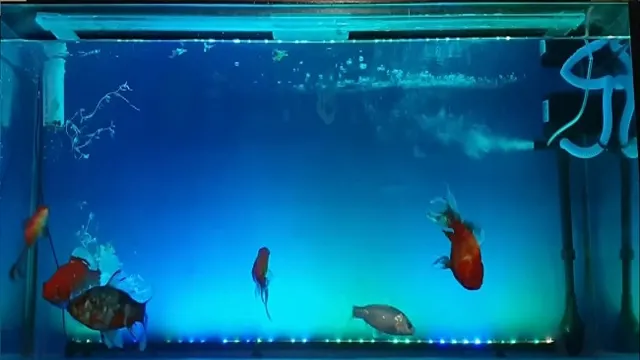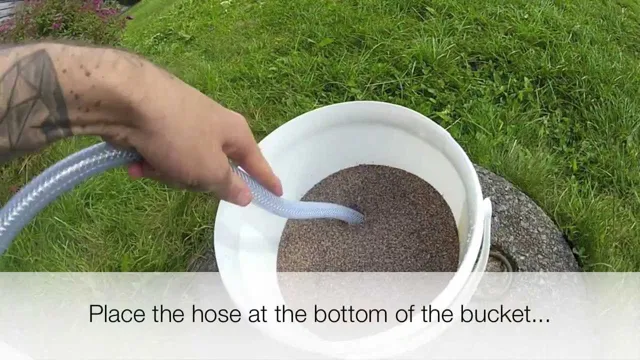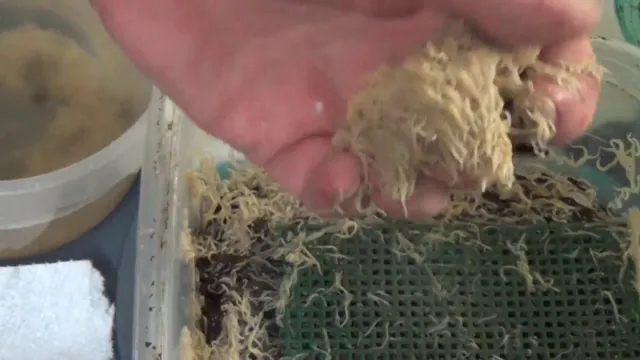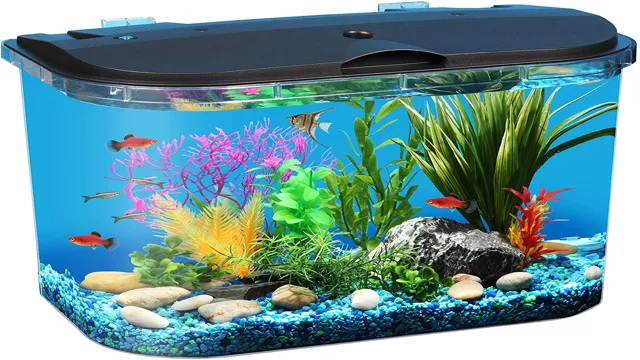Do you ever find that the flow from your powerhead in your aquarium is too strong for your delicate aquatic creatures? Perhaps your plants are being tossed around, or your fish are struggling to swim against the current. Luckily, reducing the flow is possible and doesn’t require purchasing a new powerhead altogether. In this blog post, we will discuss various methods to decrease the flow of your aquarium powerhead, ensuring a comfortable environment for your aquatic pets to thrive in.
By implementing a few simple techniques, you can ensure a healthy and peaceful aquarium for all.
Understanding Aquarium Powerheads
If you have an aquarium and you find that your powerhead is too strong, there are ways to reduce its strength. One option is to use a flow diverter, which will redirect the current and spread it out more evenly throughout the tank. Another option is to use a spray bar, which will create a gentle flow by dispersing the water over a larger area.
You can also try reducing the flow rate on the powerhead itself by adjusting the flow control valve or by using a smaller nozzle or diffuser. It’s important to note that while reducing the strength of your powerhead may seem like a good idea, it’s essential to maintain a proper water flow in your aquarium for the health of your fish and other aquatic life. By finding the right balance of flow and strength, you can ensure a healthy and thriving aquatic environment.
What Is an Aquarium Powerhead?
An aquarium powerhead is a device used to pump water in an aquarium to create water movement. It is essentially a water pump that generates a current in the aquarium. Aquarium powerheads are essential for ensuring that the water in an aquarium is properly circulated.
This is necessary to get rid of dead spots and to ensure that the water is properly filtered. A powerhead is also important for maintaining healthy fish by preventing the buildup of harmful bacteria and algae. When choosing an aquarium powerhead, it is important to consider the size of the tank, the type of fish in the aquarium, and the type of filtration system that is in place.
It is also important to choose a powerhead that is energy efficient, durable, and easy to install. Overall, an aquarium powerhead is an essential piece of equipment for any aquarium owner who wants to maintain a healthy and thriving aquatic environment.

Why Would You Want to Reduce Its Flow?
Aquarium powerheads are popular tools used by fish enthusiasts to help maintain their tanks’ water quality, temperature, and oxygen levels. However, there are situations where you may want to reduce the powerhead’s flow rate. For example, a powerful current can stress or injure delicate or slow-moving fish, or disturb the substrate and plants, creating unnecessary debris in the tank.
Furthermore, some species of fish prefer calmer waters in their natural habitat, and reducing the flow rate can mimic these conditions to create a more suitable environment for them. To reduce the powerhead’s flow, you can adjust the valve or install a flow regulator to divert some of the water flow. In doing so, you can help create a more balanced and vibrant ecosystem for your fish to thrive in.
Ways to Reduce the Flow of Your Aquarium Powerhead
If you’re wondering how to make your aquarium powerhead not as strong, there are a few methods you can try. One option is to add some filter media, like sponge or filter floss, in front of the powerhead. This will create more resistance and reduce the flow.
Another option is to attach a flow deflector to the powerhead. This will spread out the flow and make it less forceful. You can also try positioning the powerhead differently, towards the surface or facing a wall, to reduce the flow. (See Also: How to Boil Lace Rock for Aquarium: A Step-by-Step Guide to Ensuring a Safe and Clean Environment for Your Fish)
Finally, you can adjust the flow rate on the powerhead itself if it has that functionality. By following these steps, you can find a method that works for you and create a more comfortable environment for your aquarium inhabitants.
Adjusting the Flow Control Valve
If you want to reduce the flow of your aquarium powerhead, adjusting the flow control valve is the way to go. This can be done by turning the valve clockwise to restrict the flow or counterclockwise to increase it. However, make sure to do this gradually and monitor your aquarium to ensure your fish and plants are not being adversely affected.
A sudden change in water flow can cause stress to aquatic life, leading to health issues or even death. It’s important to strike a balance between adequate water movement and gentle flow. It’s like finding the perfect speed for cruising in your car- too slow, and you won’t get anywhere, too fast, and you risk losing control of your vehicle.
Finding the sweet spot between flow and tranquility will create a healthy and thriving aquatic environment for your beloved pets. So, take your time, experiment, and find the ideal flow rate that works for your aquarium.
Installing a Flow Restrictor Device
If you’re struggling with controlling the water flow in your aquarium powerhead, consider installing a flow restrictor device. These handy gadgets are simple to use and can significantly reduce the flow inside your tank to create a more suitable environment for your aquatic pets. Flow restrictors come in various shapes and sizes and can be precisely adjusted to fit your specific needs.
They work by reducing the flow of water coming out of your powerhead, which can help prevent your fish from getting harmed or sucked into the filter system. By using a flow restrictor, you can maintain a healthy flow rate that is both safe and efficient for your aquarium. So if you want to reduce the water velocity in your tank without changing your entire filtration system, a flow restrictor is definitely worth considering.
Adding a Diffuser or Nozzle
If you’re looking to reduce the flow of your aquarium powerhead, adding a diffuser or nozzle is a great option. These attachments help to break up the flow of water, creating a gentler current for your fish and other aquatic life. A diffuser spreads out the water, while a nozzle can be adjusted to direct the flow in a specific direction.
Both options are easy to install and can make a big difference in the overall comfort of your aquarium inhabitants. So if you’re tired of strong currents causing stress and discomfort for your fish, consider adding a diffuser or nozzle to your powerhead setup!
How to Choose the Right Method for Your Tank
If you’re looking to reduce the strength of your aquarium powerhead, there are a few methods you can try to make the water flow more manageable for your fish and plants. One option is to use a flow diverter, which redirects the water flow and helps to reduce the intensity of the current. Another alternative is to add a spray bar to your powerhead, which divides the water flow into smaller streams and minimizes the overall strength. (See Also: How to Make Aquarium with PVC Pipe: A Step-by-Step Guide)
Alternatively, you can try adjusting the positioning of your powerhead, as placing it closer to the surface of the water can help to diffuse the flow and make it less forceful. Ultimately, the right method for your tank will depend on the specific needs of your aquatic pets, so be sure to research your options and experiment to find the optimal solution for your setup. With these strategies, you can ensure that your fish and plants thrive in an environment that promotes natural, healthy behavior.
Factors to Consider
When it comes to choosing the right method for your tank, there are several factors to consider. First and foremost, you need to think about the type of tank you have and what kind of environment you’re trying to create. Different methods work better for different setups.
For example, if you have a planted aquarium, you may want to opt for a CO2 injection system to help your plants thrive. On the other hand, if you have a saltwater tank, a protein skimmer might be a better choice to keep your water clean and clear. You also need to consider your budget and how much time and effort you’re willing to put into maintaining your tank.
Some methods require more maintenance than others, so it’s important to find one that fits your lifestyle. By taking these factors into account, you can choose the right method for your tank that will help you create a healthy and thriving aquatic ecosystem.
Matching Your Powerhead to Your Tank Size
When it comes to choosing the right powerhead for your tank, it is crucial to consider your tank size. This will determine the strength and flow rate of the powerhead you need to maintain a healthy environment for your aquatic pets. There are two methods for matching your powerhead to your tank size.
The first method is to follow a general rule of thumb, which is that your powerhead should be able to circulate at least five times the volume of water in your tank every hour. This means that for a 50-gallon tank, you will need a powerhead that can move around 250 gallons per hour. The second method is to use a more accurate formula that takes into account the specific dimensions of your tank.
To use this method, you will need to measure the length, width, and height of your tank and apply a specific calculation to determine the flow rate you need. Remember, choosing the right powerhead is crucial for maintaining a healthy and happy tank environment for your aquatic friends.
Conclusion
In conclusion, if you feel like your aquarium powerhead is too strong, fear not! The solution is as simple as an old t-shirt or pantyhose. By wrapping the offending powerhead with these materials, you can reduce the force of the water flow without sacrificing the health of your aquatic pets. So next time you’re struggling with a stubbornly strong powerhead, remember that some good old-fashioned DIY ingenuity can go a long way in keeping your aquarium just right.
“
FAQs
What causes aquarium powerheads to become too strong?
Aquarium powerheads can become too strong due to a few factors such as the size of the pump, the water flow rate, and the positioning of the powerhead in the aquarium.
(See Also: How to Build Acrylic Aquarium Tanks: A Step-by-Step Guide for Beginners)
How can I adjust the strength of my aquarium powerhead?
You can adjust the strength of your aquarium powerhead by installing a flow control valve or using a flow deflector to redirect the flow. Some powerheads also come with adjustable flow settings.
Can I reduce the strength of my powerhead without buying additional equipment?
Yes, you can try reducing the flow rate by partially blocking the outlet with a sponge or filter floss. However, this may affect the overall filtration and oxygenation of the aquarium.
Can a too-strong powerhead harm my aquarium’s inhabitants?
Yes, a too-strong powerhead can harm your aquarium’s inhabitants by creating strong currents that may stress or injure fish, corals, and other aquatic life.
Can I use multiple powerheads to create a more even flow throughout my aquarium?
Yes, using multiple powerheads in different locations can help create a more even flow and reduce any excessive flow in one particular area.
What are some alternative methods to powerheads for water circulation in aquariums?
Some alternative methods include using air stones, wave makers, water pumps, or canister filters with adjustable flow settings.
Is it possible to completely eliminate strong currents in an aquarium?
No, some currents are necessary for maintaining a healthy aquatic environment. However, you can adjust the strength and direction of the currents to ensure they are not harmful to your aquarium’s inhabitants.







